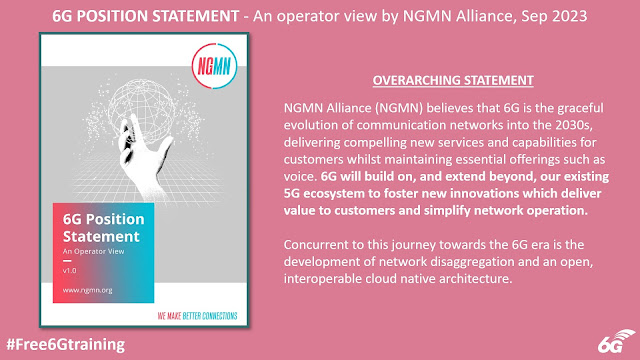NGMN, established in 2006, is a global, operator-led alliance of over 80 companies and organisation spanning operators, manufacturers, consultancies and academia. They currently have over 20 mobile operators as their members including BT, China Mobile, Deutsche Telekom, Orange, Vodafone, Telefónica, SK Telecom and NTT Docomo.
They recently published a 6G position paper emphasising the needs for a new paradigm for graceful evolution and successful value creation and delivery. Their press release said:
The publication serves as a comprehensive guide, outlining how Network Operators envision the realisation of a successful evolution to 6G and issuing a call to the industry to embrace this transformative direction. The publication covers an operator position on such key requirements and design considerations as network simplification, absolute energy reduction, network AI transformation & predictive network management, safe and resilient infrastructure, global 6G standards, software upgrade to 6G, no intrinsic need for hardware refresh, no compromise to existing services (Voice) and access across mobile, fixed and non-terrestrial networks.
Following the NGMN publications “6G Use Cases and Analysis”, “6G Drivers and Vision” and “6G Requirements and Design Considerations”, this latest publication “6G Position Statement: An Operator View” marks the next step towards guidance for E2E requirements for 6G.
The full 6G Position Statement can be downloaded here.
My current summary of the MNOs' views on 6G https://t.co/qxzFfjRSXs pic.twitter.com/YhPb62bHml
— Dean Bubley (@disruptivedean) September 29, 2023
Iain Morris in Light Reading article reminds the readers:
Howard Watson, the most senior technology executive at the UK's BT, once developed the thousand-yard stare of men who have fought bloody wars when asked if 6G would trigger another big equipment upgrade. "We are not doing that again," he said in apparent horror at this year's Mobile World Congress (MWC). It now seems that other telcos are not up for doing it again either.
A position statement on 6G released this week by the NGMN, a club of telcos, could not make it clearer. "6G must not inherently trigger a hardware refresh of 5G RAN infrastructure," say the report's authors, who include Luke Ibbetson, the head of research and development for Vodafone, and Javan Erfanian, a distinguished member of the technical staff at Bell Canada. Where possible, they go on to say, operators must be able to introduce 6G through "software-based feature upgrades of existing network elements."
By now, traditional equipment vendors must be feeling as sweatily nervous as men about to fight bloody wars. Take Sweden's Ericsson, the world's biggest vendor of 5G technology outside China. Despite years-old efforts to kindle standalone software businesses, it still generates about two-thirds of its revenues at its mobile networks unit. Product highlights these days include slimline radio units for massive MIMO, an antenna-rich 5G technology. Promotional images typically feature women of average size carrying them like plastic supermarket bags to emphasize just how lightweight they are.
Yanitsa Boyadzhieva says in her Telecom TV article:
Indeed, the statement specifically notes that “6G must not inherently trigger a hardware refresh of 5G RAN infrastructure”. Instead, any decision to refresh 5G hardware should be based purely on operational requirements, such as reaching end-of-life, reducing energy consumption or adding new capabilities, and should be “independent of supporting 6G”.
Specifically, the publication outlines a number of guiding principles for the next generation of wireless connectivity, such as the need for 6G mobile network standards to be “globally harmonised” and for the technology to come with “robust security measures” by design.
Equally important is that the introduction of 6G needs to allow “certain scenarios to be realised through software-based feature upgrades of existing network elements to meet 6G requirements,” but the technology should not worsen the performance for 5G customers and new features should not compromise core connectivity services, such as voice.
The publication further draws attention to the need for 6G to facilitate seamless integration and interoperability with fixed and satellite networks, and to support network-related application programming interfaces (APIs) to push new services.
I have always said that NSA was a hack, like CS Fallback in 4G 👇. After 10+ years, VoLTE adoption still has outstanding issues.
— Zahid Ghadialy (@zahidtg) January 19, 2023
NSA allows operators to show the 5G logo and faster data rates, why bother with SA? It will eventually come...https://t.co/g4Twjs321e
Personally, I think this is a very timely statement as the industry gets ready to start 6G standardisation process. It is important to take time and ensure that the specifications are fit for purpose rather than add another hack. I don't think it would be the end of the world if some MNO can't launch their 6G network in 2027/28.
Related Posts:
- Free 6G Training: 6G News and Announcements from MWC 2023
- Free 6G Training: NGMN Whitepaper on '6G Requirements and Design Considerations'
- Free 6G Training: NGMN Releases 6G Use Cases and Analysis White Paper
- Free 6G Training: NGMN's 6G Vision and Roadmap


Comments
Post a Comment